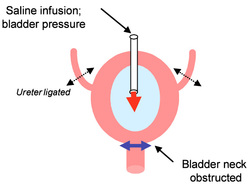Urodynamic evaluation (isovolumetric cystometry)
OBJECTIVES
- Examines the behaviour of the urinary bladder after acute and complete ligation or blockade of the bladder neck and urethra, removing the ability of the bladder to empty thereby creating an isovolumetric system
- Allows the investigation of the effect of a drug on the amplitude and the frequency of rhythmic bladder contractions
SPECIES
rat, guinea pig
 |
| Figure 1: Representative isovolumetric cystometrograms in an anesthetized normal rat. |
Summarized methodology
A catheter is inserted through the bladder dome allowing simultaneous bladder perfusion and bladder pressure monitoring. The urethral meatus is ligated removing the ability of the bladder to empty and so creating an isovolumetric system. Upon filling the bladder in the isovolumetric state, bladder volume increases until a micturition event is evoked, at which time filling is stopped and the bladder then continues to generate rhythmic isovolumetric contractions of similar amplitude, frequency and duration.
 |
Endpoints
- Frequency of bladder contractions (indicative of afferent function of the micturition reflex)
- Amplitude of bladder contraction (indicative of smooth muscle function)
Related Pelvipharm bibliography
Non disclosable information for confidentiality reasons.

Links to applicable Targeted disorders / Pathophysiological models





















 Download this page in PDF
Download this page in PDF